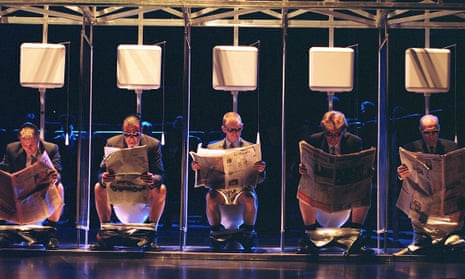Meet Looie: it’s like Uber, but for bodily functions. Looie is a new app that promises you access (for a fee, naturally) to private bathrooms, all of which have been certified for hygiene and cleanliness.
“[Y]ou’re getting a consistent, amazing experience all the time,” explained Looie founder Yezin Al-Qaysi earlier this year. “You won’t have to flush with your foot anymore.”
Whether this particular venture will take off is anyone’s guess. After a burst of publicity in July, the Looie website now seems ominously quiet. But even if Al-Qaysi’s project proves a busted flush, the concept’s an obvious application of the logic behind the so-called “sharing economy”, where digital technology gets fused with user-pays economics so as to marketise personal services.
It’s fascinating, though – toilets have been here before. That history helps us think about the contradictory nature of the sharing economy.
On the one hand, Uber and Airbnb are wildly popular, both on the verge of world domination. On the other, a backlash is mounting too, with (sometimes quite violent) protests against Uber in Paris, Madrid, Barcelona, Berlin, Rome, Milan, Mexico City and London, and campaigns against Airbnb in Barcelona, San Francisco and elsewhere.
The commercial toilet has an equally chequered past. In a terrific piece for Pacific Standard, Aaron Gordon explains how, in the early years of the 20th century, American train stations often featured the only modern plumbing in town.
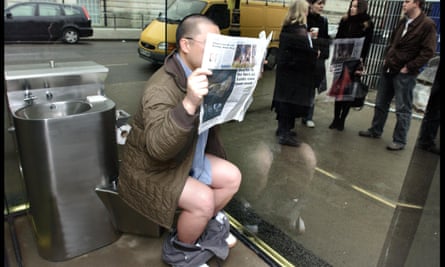
To keep the public out of its privies, rail magnates took to restricting access, first with a key and later via coin-operated locks. The technology quickly spread, as other corporations seized the chance to make big money from the littlest room.
Gordon estimates that, by 1970, America had over 50,000 pay toilets, scattered throughout airports, bus depots and other public places.
The toilet moguls soon found themselves facing off against a grassroots campaign to free the WC.
“We feel that pay toilets are unjust infringements on our basic human rights,” explained Michael Gessel in the first newsletter of the Committee to End Pay Toilets in America (Ceptia), an activist group formed in 1970. “Elimination is an important body function that must take place, dime or no dime.”
Ceptia called its publication The Free Toilet Paper, a masthead carrying the the slogan “Flush for Freedom”. Their anthem insisted: “We’ll work until we know / that toilets in America / Are free where-e’er we go / We’ll flush them out! / We’ll wipe them out! / We pledge, O Ceptia!”
Behind the potty jokes, Ceptia’s campaign reflected the changing sensibilities of a generation radicalised by the struggle against the Vietnam War. Ceptia’s Ira Gessell agreed.
“When a man’s or woman’s natural body functions are restricted,” he said, “because he or she doesn’t have a piece of change, there is no true freedom.”
It was a rhetoric shaped by the liberation movements of the 70s, with a characteristic emphasis on freedom, choice and the illegitimacy of social restrictions on nature. Not surprisingly, pay toilets were also condemned for sexism, since men’s urinals were free whereas facilities for women were not.
When the private toilet owners defended their businesses, they did so in terms that implicitly echoed Ceptia’s sense of what was at stake. In Chicago, store owners called charging for toilets “a constitutional right”; Nik-O-Lok and American Coil Lock Company (the two biggest manufacturers of toilet door mechanisms) claimed that their products “discourage drug addicts, homosexuals, muggers and just plain hippies from haunting public restrooms”.
But the tide was turning as inexorably as the water in a backed-up S-bend. In California, assemblywoman March Fong Eu led a protest in which a toilet draped in chains was smashed in front of the California State Capitol. She proposed legislation banning pay toilets in public areas anywhere in the state.
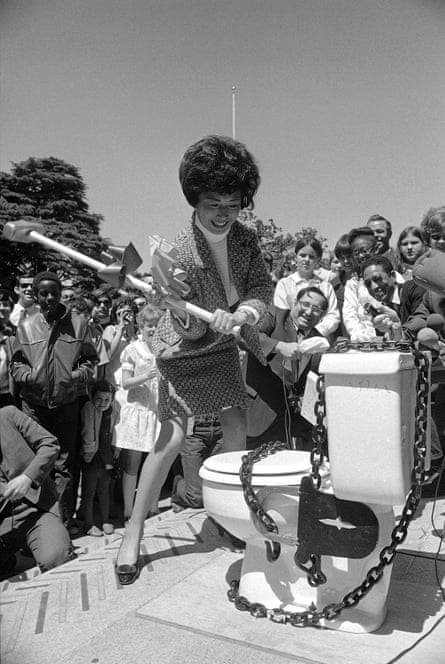
Then, in 1973, Chicago mayor Richard Daley told the press that he’d remove pay toilets from the city’s airports, explaining that he “did it for women’s lib”. In quick succession, anti-pay toilet legislation appeared in Chicago, Alaska, Florida, Iowa, Nevada, New York and New Jersey.
By June 1976, Ceptia declared victory, announcing its dissolution with characteristic aplomb: “There are so many anti-pay toilet bills being introduced around the country that [we] can no longer keep track of all of them. Ceptia ... wasn’t making a bid for power: its end was its own elimination.”
Times have changed. To understand why, despite that history, people in 2015 might be willing to pay a king’s ransom for a clean throne, let’s return to that interview with Looie founder Yezin Al-Qaysi.
In the conversation, he talks about how selling water seemed, at one stage, just as unlikely: “All of a sudden you’re bottling up water and you’re selling it.”
If you can monetise the liquid going into a human body, you should be able to make a buck when it comes out. Indeed, the recent history of bottled water makes a fascinating story.
The provision of clean water to industrialised cities was one of the great social accomplishments of modernity, massively reducing the urban death rate. In the 19th century, the free drinking fountain reflected that sense of achievement: itself, both a useful service and a public monument, an ostentatious celebration of society’s ability to supply the basic necessities of life.
When, in 1859, the wonderfully-named Metropolitan Drinking Fountain and Cattle Trough Association unveiled London’s first drinking fountain, a huge crowd gathered to see the water flow.
Eventually, some 7,000 people were using the facility each day – and the obvious demand led to the construction of an additional 85 water fountains over the next six years. By 1879, Londoners could sip from almost 800 free bubblers.
A similar process took place in the USA, with the New York Times spearheading, from the 1850s on, a campaign for free drinking facilities. Joe Satran notes that:
[W]ell into the 1880s, new fountains were considered significant enough to warrant news stories in major newspapers. And large crowds would gather to watch them be turned on. In 1881, The New York Times wrote that a thousand people were present at the opening of the water fountain in Union Square.
The construction of public drinking facilities and the proliferation of high quality plumbing essentially ended the trade in water. By 1930, bottled water was perceived as a symbol of backwardness, since it suggested your house or workplace hadn’t been connected to the public supply.
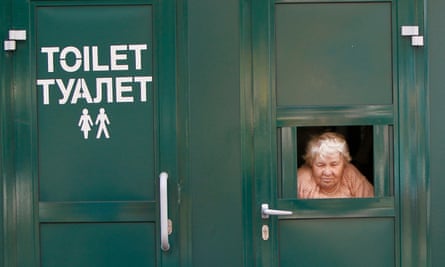
Today, as Al-Qaysi recognised, the situation’s been entirely reversed. Bottled water is big business, sold in huge quantities by multinationals like Coke and Pepsi – and the rise of private drinking has corresponded with the decline of the public fountain.
“Water fountains used to be everywhere,” writes Peter Gleick, “but they have slowly disappeared as public water is increasingly pushed out in favour of private control and profit.
“Water fountains have become an anachronism, or even a liability, a symbol of the days when … bottled water wasn’t available from every convenience store and corner concession stand.”
Gleick also notes the conscious campaign waged by the water giants to change our attitudes to drinking. In 2000, Robert S Morrison, who would go on to become chairman of PepsiCo’s North American Beverage and Food division, explained: “The biggest enemy is tap water … We’re not against water – it just has its place. We think it’s good for irrigation and cooking.”
Likewise, Susan Wellington, from the Quaker Oats Company’s American beverage division, boasted that, “When we’re done, tap water will be relegated to showers and washing dishes.”
In her book Bottlemania, Elizabeth Royte documents the results:
Airports undergoing renovation keep losing their water fountains,’ she says, ‘while coolers stocked with Fiji proliferate. Well-maintained fountains are becoming about as scarce as working pay phones.
The cycle that sets in can be described either as virtuous (if you’re a beverage company) or vicious (if you’re anyone else). As free drinking water becomes harder to find, bottled water becomes more and more popular, thus reducing the pressure on authorities to care for fountains and the like, until the dire state of the facilities makes buying water almost mandatory.
An ideological shift takes place as well, with fountains perceived as unsanitary and gross, and bottled water a signifier of health and vitality.
Yezin Al-Qaysi’s interview makes clear that the future of Looie depends on the same dynamic manifesting itself in the bathroom, as customers pony up a monthly subscription to avoid disgusting and badly-maintained public conveniences.
If the service achieved an Uber-like ubiquity, its success would contribute to the decline of public toilets, both because they’d be seen by private providers as a competition and because the government would be under little pressure to fund a service used only by the poor and the desperate.
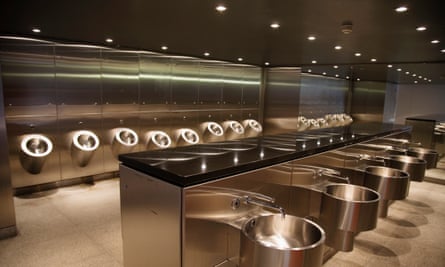
By and large, that’s how the so-called “sharing economy” works: what’s presented at first as a choice for tech savvy early adopters becomes, eventually, an obligation on everyone, as the user-pays juggernaut crushes its rivals.
In Los Angeles, for instance, the ubiquity of Airbnb has fostered a protest coalition, bringing together housing activists who say the service forces up rentals and unionists concerned about the downward pressure on the already minuscule wages of hotel workers, while taxi drivers worldwide have been rallying against Uber’s effects on their wages and conditions.
“Uber came to our country and completely destroyed our social economy,” says Miguel Chacon, a representative of the drivers in Mexico City.
These services are, after all, almost the dream product for free market ideologues. No need for the government to fund public transport or housing: turn the entire sphere over to thousands of mini-entrepreneurs and let the market work its magic.
In a 1975 feature on Ceptia, the columnist Peter Gruenstein expressed the era’s deep revulsion at private greed, in a satirical piece where he noted:
America has accepted the spread of the pay toilet, now a $2 million a year industry. That acceptance is importance because it firmly establishes a basic tenet of a true free market economy: that a fee can be placed on anything for which there is a demand … And it is not hard to forsee the day when what are presently considered “free” services will be recognised by creative capitalists for what they are – profit opportunities.
That day has pretty much arrived. In response to the high-tech privatisation of social services, it’s tempting for progressives to retreat to unabashed nostalgia.
Think of Ken Loach’s film The Spirit of 45, a documentary that explicitly contrasts the dog-eat-dog competition of modern Britain with the Labour administration elected in 1945: essentially, the highpoint of the British welfare state.
“The central idea was common ownership,” Loach says, “where production and services were to benefit all. The few should not get rich to the detriment of everyone else. It was a noble idea, popular and acclaimed by the majority.”
“Maybe it is time to remember it today.”
The enthusiasm inspired by the Jeremy Corbyn campaign for the leadership of the British Labour Party shows there’s something in Loach’s invocation of the “generosity, mutual support and co-operation” in which an earlier generation of social democrats believed.

Certainly, the idealism of the immediate postwar world – or, for that matter, on display in Ceptia – makes a startling contrast with the destructive greed that sees every human need as an opportunity to exploit.
Let’s remember that the shift from public to private water doesn’t merely allow beverage companies to become stinking rich – it also devastates the environment, as corporations plunder ancient aquifers and then package the liquid they extract in plastic manufactured from vast quantities of oil.
At the same time, it would be wrong to understand the rise of bottled water as merely a conspiracy. Yes, the corporations waged a prolonged PR offensive to change attitudes to tap water. But, in doing so, they also exploited genuine and legitimate human desires.
It’s a point made by Jeremy Gilbert, in a fascinating discussion of Oscar Wilde’s often-neglected political writings (particularly The Soul of Man under Socialism). Gilbert noted that the political consensus of the welfare state in the immediate postwar years:
[It] always depended on a very measured and modest set of expectations from those worker-consumers, happy to accept a limited range of lifestyle choices and social identities: men were expected to accept their role as breadwinner and paterfamilias with very little variation in how these roles could be interpreted; educational options were narrowly restricted at all levels of society; immigrants were expected to assimilate; it was possibly the worst time in history to be gay; there were very few choices for the woman who didn’t want to be a housewife, etc. And this lack of freedom went along with a very modest range of choices in the marketplace: ‘You can have any colour you like, as long as it’s black,’ Henry Ford famously told his customers.’
The welfare state during the postwar boom provided security – but a security that could feel stultifying, even oppressive. The “common ownership” Loach invokes meant state control, with services that were centralised and uniform and often bureaucratised. As a result, entrepreneurs could chip away at “the Spirit of 45” by offering individuality and choice instead of security and protection.
You can see that process at work in the successful effort by the beverage companies to legitimise the sale of bottled water. The key concept the marketers played upon was choice. That might seem improbably, given the product they offered was, at its core, identical to what came out of the tap (water is water is water) but savvy PR campaigns transformed particular brands of water into statements of personality, so that, by the 1980s, if you sipped from a bottle of spring water, you were signaling your European sophistication.
In her movie Truth and Dare, Madonna famously fellated an Evian bottle; thereafter, even those who drank (rather than deep-throated) Evian’s products could believe that, like Ms Cicione, they were free-spirited sexual libertines.
As trivial and inane as those examples seem (particularly when contrasted with the immense destructiveness of the bottled water industry), the marketing campaign worked because it connected with a basic human need for self-expression.
Think about that Henry Ford quote. A black car is infinitely preferable to no form of transport at all. At the same time, many people devote hours upon hours of unpaid time to pimping their ride, because they understand their vehicle as a statement of identity. In the 21st century, a social system that doesn’t provide outlets for that desire will not survive.

“There were many reasons,” continues Gilbert, “why [the postwar welfare state model] stopped working, but one of them was the fact that the 1960s posed in a very public way the question on which Wilde invites us to reflect: why, in a world of plenty, should every one of us not aspire to the life of an aesthete, a dandy, a sensualist; and what, indeed, is the point of eliminating poverty at all, if not to enable such a possibility to be actualised? It was this desire, as much as any other, which neoliberalism captured, capitalised, monetised, and sold back to us in debased forms.”
The sharing economy provides the perfect example. The various platforms have become so incredibly popular because they address us as, first and foremost, subjects rather than objects – sovereign individuals making our own decisions about how we travel, where we stay and the particular bathroom in which we might wish to urinate.
Of course, in reality, the market rarely delivers what it promises. You don’t transform into Madonna by drinking Evian; indeed, as we have seen, the “freedom” promised by bottled water gave way to compulsion, as the sources of public water dried up.
Nevertheless, Gilbert’s point is important – a progressive alternative must offer a more expansive definition of freedom, not a narrower one.
But the same social system that prevents us from living a good life also gives us a glimpse of what that life might be like. That’s why progressives can’t respond to the sharing economy and similar developments with nostalgia for the social democratic past. Marx insisted an alternative to capitalism must be based on the innovations that capitalism has made possible – or else, he warned, “the old crap would revive”.
That wasn’t necessarily a premonition about Looie. But think of Ceptia’s insistence that pay toilets are infringements on our human rights. What would happen if the technological wizardry used to monetise bathrooms was instead deployed to make free facilities more accessible and better maintained?
How could a Uber-style app transport people in a way that grew rather than destroyed the social economy? What kind of social co-ordination and democratic decision-making might be feasible through the digital interfaces to which we’re all now so accustomed? Most of all, what might individual creativity look like in a society based on solidarity rather than competition?
They sound like utopian questions – and to an extent they are. But by asking them, we get a glimpse of a different kind of freedom, lurking in the very bowels of the present.
